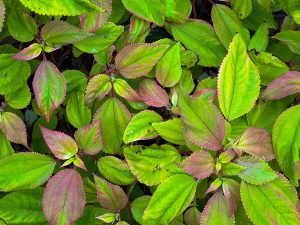Flora of Hawaii: Mamaki

Mamaki is an endemic species: plants are only found and grow in Hawai’i
Botanical name: Pipturus albidus (it is part of the nettle family, Urticaceae)
Common Name: Waimea pipturus (on Kauai)
Range: Found on all Hawaiian Islands except Kaho’olawe and Ni’ihau. Grows in costal mesic, mixed mesic and wet forests at elevations of 200–6,000 ft. It is a shrub that can grow between 5-20 feet, as tall as a small tree. It is commercially grown on the big island.
Flowers: small, white and furry, they grow attached to the stem and transform into fruit.
Fruit: small and white, spotted with seeds. It grows attached to the stems. It is edible but eating too many may cause diarrhea.
Seeds: The fruit contains tiny brown seeds, which can be harvested and planted to propagate.
Leaves: broad oval leaves with three large veins (often tinged with red underneath) radiating from the base. They range in size from four inches up to a foot across and come to a point. They can be corse to the touch and have small teeth along each edge. Edible cooked or raw, dried and brewed to make tea. The color of the top of the leaves range from light green to green pink or reddish. The underside of the leaf is pale, almost white and are covered with small hairs.
Traditional and Medicinal Uses: The leaves of the plant are picked and dried, then brewed with hot water and drunk like tea. Mamaki Tea contains antioxidants and was used for medicinal purposes to promote good health and longevity. The Hawaiians used the inner fiber of the tree bark to make a type of kapa (cloth) and kaula (rope). The fruit was given to pregnant women and infants to prevent thrust and also used to dress wounds.
Mamaki Tea: it tastes naturally sweet with nutty, earthy tones. It steeps to a deep red color like rooibos. The more color in the leaves, the more bitter the tea.
Hawaiian Legend: Hawaiian chants refer to Mamaki as the “Healer of the Forest.”
Benefits to the Environment: host for the caterpillars of the native endangered Kamehameha butterfly (Vanessa tameamea), and the green Hawaiian blue butterfly(usdara blackburni). It is thought to benefit damaged soil by adding nitrogen andregenerates.
Propagation: fruit should be harvested when soft to the touch to collect the seeds. It grows well in the shade and if watered regularly it can also grow in direct sunlight.
Mamaki is the featured image on the banner of the September 1, 2022 HTMC newsletter.
Article written with assistance from John B. Hall.
Sources:
A Hiker’s Guide to Trailside Plants in Hawaii by John B. Hall (Mamaki – pg. 92-93)
Hawaii Horticulture blog: http://hihort.blogspot.com/2011/11/makami-hawaiian-medicinal-plant.html
Onolicious Hawaii: https://onolicioushawaii.com/mamaki/
Legendary Origin of Kapa: (Mamaki mentioned pg.64): https://www.gutenberg.org/files/66547/66547-h/66547-h.htm#polynesian


